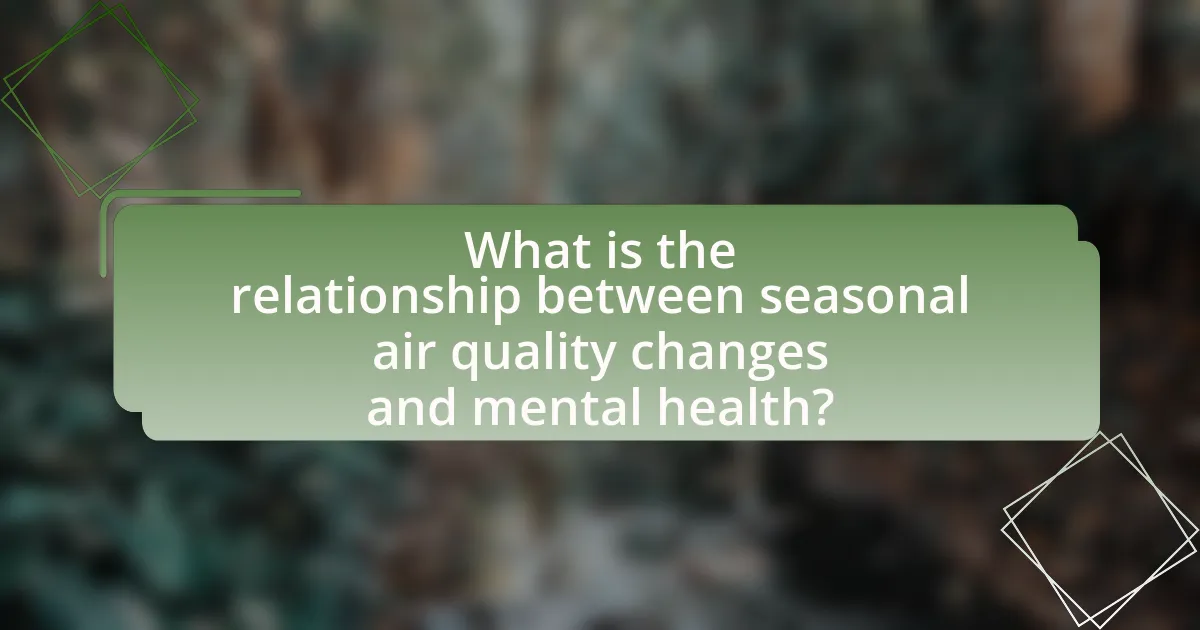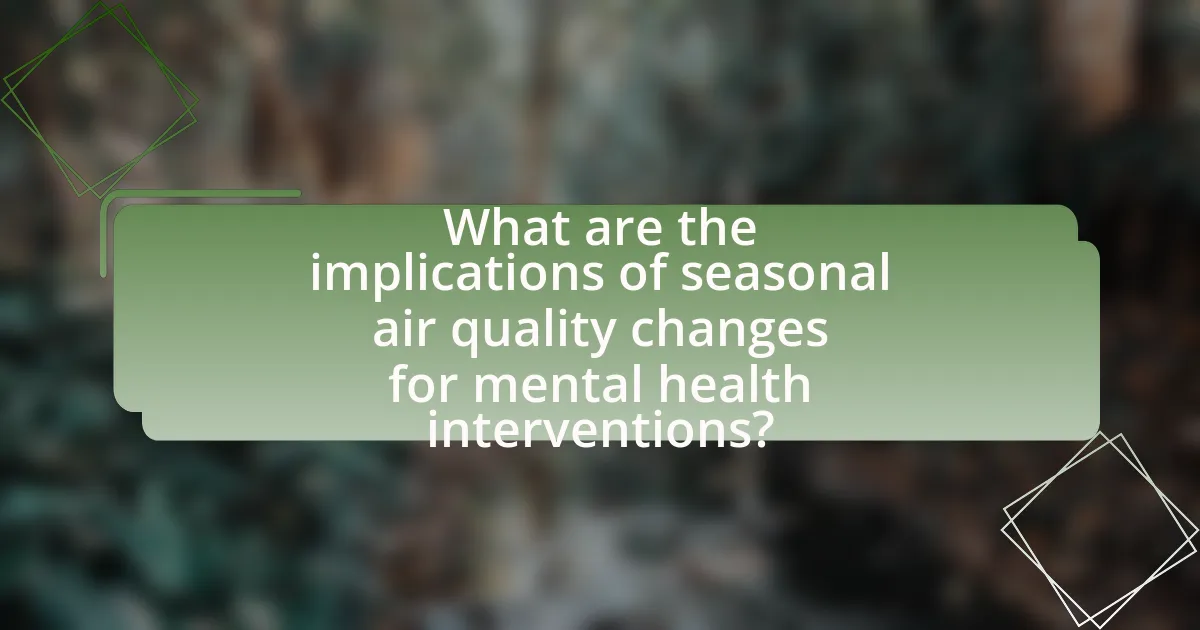The article evaluates the impact of seasonal air quality changes on mental health, highlighting the correlation between poor air quality and increased rates of anxiety, depression, and cognitive decline. It discusses specific pollutants, such as particulate matter and nitrogen dioxide, and their mechanisms affecting mental health, including neuroinflammation and oxidative stress. The article emphasizes the importance of monitoring air quality, understanding individual vulnerabilities, and implementing public health strategies to mitigate mental health risks associated with seasonal fluctuations in air pollution. Additionally, it outlines practical measures individuals can adopt to protect their mental well-being during periods of poor air quality.
What is the relationship between seasonal air quality changes and mental health?

Seasonal air quality changes significantly impact mental health, with evidence indicating that poor air quality correlates with increased rates of anxiety, depression, and other mental health disorders. Studies have shown that exposure to pollutants, such as particulate matter and nitrogen dioxide, can lead to neuroinflammation and oxidative stress, which are linked to mental health issues. For instance, research published in the journal “Environmental Health Perspectives” found that individuals living in areas with higher levels of air pollution reported more symptoms of depression and anxiety. This relationship underscores the importance of monitoring air quality as a factor in mental health assessments and interventions.
How do seasonal air quality changes affect psychological well-being?
Seasonal air quality changes significantly affect psychological well-being by influencing mood and cognitive function. Poor air quality, often exacerbated during certain seasons due to factors like pollen, pollution, and temperature inversions, has been linked to increased rates of anxiety and depression. Research indicates that exposure to high levels of air pollutants, such as particulate matter and nitrogen dioxide, can lead to neuroinflammation, which negatively impacts mental health. A study published in the journal “Environmental Health Perspectives” by researchers at Harvard University found that individuals living in areas with higher air pollution levels reported lower mental health scores, demonstrating a clear correlation between air quality and psychological distress.
What specific air pollutants are most impactful on mental health?
Specific air pollutants that are most impactful on mental health include particulate matter (PM2.5), nitrogen dioxide (NO2), and sulfur dioxide (SO2). Research indicates that exposure to PM2.5 is linked to increased rates of anxiety and depression, as demonstrated in a study published in the journal Environmental Health Perspectives, which found that higher levels of PM2.5 correlate with a rise in mental health disorders. Additionally, nitrogen dioxide exposure has been associated with cognitive decline and mood disorders, as noted in a study by the University of California, Berkeley, which highlighted the negative effects of urban air pollution on mental well-being. Sulfur dioxide has also been implicated in exacerbating mental health issues, particularly in vulnerable populations, according to findings from the World Health Organization.
How do different seasons influence the levels of these pollutants?
Different seasons significantly influence the levels of air pollutants due to variations in temperature, humidity, and atmospheric conditions. For instance, winter often sees increased levels of particulate matter and nitrogen dioxide due to heating emissions and stagnant air conditions, while summer can lead to higher ozone levels due to increased sunlight and temperature, which facilitate photochemical reactions. Studies have shown that in urban areas, the concentration of ground-level ozone can rise by 20-30% during warmer months, impacting air quality and potentially affecting mental health.
Why is it important to evaluate the impact of air quality on mental health?
Evaluating the impact of air quality on mental health is crucial because poor air quality has been linked to increased rates of anxiety, depression, and cognitive decline. Research indicates that exposure to pollutants such as particulate matter and nitrogen dioxide can exacerbate mental health issues, as demonstrated in a study published in the journal Environmental Health Perspectives, which found that individuals living in areas with high air pollution levels reported higher instances of mental health disorders. Understanding this relationship allows for targeted public health interventions and policies aimed at improving air quality, ultimately benefiting mental health outcomes in affected populations.
What are the potential consequences of neglecting this evaluation?
Neglecting the evaluation of seasonal air quality changes on mental health can lead to significant adverse consequences, including increased mental health disorders and decreased overall well-being. Research indicates that poor air quality is linked to higher rates of anxiety, depression, and cognitive decline, particularly in vulnerable populations such as children and the elderly. For instance, a study published in the journal Environmental Health Perspectives found that exposure to elevated levels of air pollution correlates with a rise in psychiatric symptoms. Without proper evaluation, these impacts may go unaddressed, resulting in a lack of targeted interventions and policies to mitigate the effects of air quality on mental health.
How can understanding this relationship inform public health policies?
Understanding the relationship between seasonal air quality changes and mental health can inform public health policies by highlighting the need for targeted interventions during specific times of the year. Research indicates that poor air quality is linked to increased rates of anxiety and depression, particularly during seasons with higher pollution levels. For instance, a study published in the journal Environmental Health Perspectives found that individuals exposed to elevated levels of particulate matter experienced a significant rise in mental health issues. This evidence suggests that public health policies should prioritize air quality monitoring and implement strategies to reduce pollution during peak seasons, thereby mitigating its adverse effects on mental health.
What are the mechanisms linking air quality and mental health?

Air quality significantly impacts mental health through mechanisms such as inflammation, oxidative stress, and neurotoxicity. Exposure to air pollutants, including particulate matter and nitrogen dioxide, can lead to systemic inflammation, which has been linked to mood disorders and cognitive decline. Studies have shown that individuals living in areas with high levels of air pollution exhibit increased rates of anxiety and depression. For instance, research published in the journal “Environmental Health Perspectives” by Power et al. (2015) found a correlation between elevated air pollution levels and the prevalence of mental health issues in urban populations. Additionally, air quality can affect neurodevelopment in children, potentially leading to long-term mental health challenges.
How do air pollutants affect brain function and mood?
Air pollutants negatively impact brain function and mood by causing neuroinflammation and oxidative stress. Studies have shown that exposure to particulate matter and gases like nitrogen dioxide can lead to cognitive decline and mood disorders. For instance, research published in the journal “Environmental Health Perspectives” found a correlation between high levels of air pollution and increased rates of depression and anxiety among urban populations. Additionally, a study by the University of California, Los Angeles, indicated that long-term exposure to air pollutants is associated with structural changes in the brain, particularly in areas responsible for emotional regulation and cognitive processing.
What biological pathways are involved in this process?
The biological pathways involved in the impact of seasonal air quality changes on mental health include the inflammatory response pathway, oxidative stress pathway, and neuroendocrine pathways. These pathways are activated by exposure to air pollutants, which can lead to systemic inflammation, increased oxidative stress, and alterations in hormone levels that affect mood and cognitive function. Research has shown that fine particulate matter (PM2.5) can trigger inflammatory cytokines, which are linked to depression and anxiety disorders, thereby demonstrating the connection between air quality and mental health outcomes.
How does exposure duration influence mental health outcomes?
Exposure duration significantly influences mental health outcomes by determining the extent of psychological stress and physiological responses to environmental factors. Prolonged exposure to poor air quality, for instance, has been linked to increased rates of anxiety, depression, and cognitive decline. Research indicates that individuals exposed to high levels of air pollution for extended periods experience a greater deterioration in mental health compared to those with shorter exposure durations. A study published in the journal “Environmental Health Perspectives” by researchers at Harvard University found that long-term exposure to fine particulate matter was associated with a 20% increase in the risk of developing depression. This evidence underscores the critical role that exposure duration plays in shaping mental health outcomes.
What role do individual differences play in this relationship?
Individual differences significantly influence the relationship between seasonal air quality changes and mental health. Factors such as age, gender, pre-existing mental health conditions, and socioeconomic status can affect how individuals respond to variations in air quality. For instance, research indicates that individuals with pre-existing respiratory issues may experience heightened anxiety or depressive symptoms during periods of poor air quality, as documented in a study by the American Psychological Association, which found that individuals with asthma reported increased stress levels during high pollution days. Additionally, younger populations may be more susceptible to the negative effects of air quality changes due to their developing cognitive and emotional systems. Thus, understanding these individual differences is crucial for tailoring mental health interventions and public health strategies in response to seasonal air quality fluctuations.
How do factors like age, gender, and pre-existing conditions affect vulnerability?
Age, gender, and pre-existing conditions significantly influence an individual’s vulnerability to health impacts from seasonal air quality changes. Older adults often experience heightened sensitivity due to age-related physiological changes and a higher prevalence of chronic conditions, making them more susceptible to respiratory and cardiovascular issues exacerbated by poor air quality. Gender differences also play a role; studies indicate that women may experience greater mental health impacts from air pollution compared to men, potentially due to biological and social factors. Additionally, individuals with pre-existing conditions, such as asthma or heart disease, face increased risks as these conditions can be aggravated by pollutants, leading to more severe health outcomes. Research has shown that populations with these characteristics are at a greater risk for adverse health effects, underscoring the importance of considering these factors in public health strategies.
What psychological factors may mediate the impact of air quality on mental health?
Psychological factors that may mediate the impact of air quality on mental health include stress, anxiety, and mood disorders. Research indicates that poor air quality can exacerbate stress levels, leading to increased anxiety and depressive symptoms. For instance, a study published in the journal Environmental Health Perspectives found a correlation between elevated air pollution levels and higher rates of anxiety and depression among urban populations. Additionally, cognitive appraisal processes, where individuals interpret and respond to environmental stressors, can influence how air quality affects mental health. This suggests that personal perceptions of air quality and its associated risks can further mediate psychological responses, impacting overall mental well-being.
What are the implications of seasonal air quality changes for mental health interventions?

Seasonal air quality changes significantly impact mental health interventions by necessitating adaptive strategies to address the varying psychological effects associated with air pollution levels. Research indicates that poor air quality, particularly during specific seasons, correlates with increased rates of anxiety, depression, and other mental health disorders. For instance, a study published in the journal “Environmental Health Perspectives” found that exposure to elevated particulate matter during winter months was linked to heightened depressive symptoms among urban populations. Consequently, mental health interventions must incorporate air quality monitoring and tailored therapeutic approaches that consider seasonal variations, ensuring that individuals receive appropriate support during periods of poor air quality.
How can communities prepare for seasonal air quality fluctuations?
Communities can prepare for seasonal air quality fluctuations by implementing monitoring systems and public awareness campaigns. Monitoring systems, such as air quality sensors, provide real-time data on pollution levels, enabling residents to take precautions during high-risk periods. Public awareness campaigns educate community members about the health impacts of poor air quality and promote actions like staying indoors on high pollution days. Research indicates that proactive measures can mitigate health risks associated with air quality fluctuations, thereby supporting mental health and overall well-being.
What strategies can be implemented to mitigate mental health risks?
To mitigate mental health risks associated with seasonal air quality changes, implementing strategies such as improving indoor air quality, promoting outdoor activities during optimal air quality days, and providing mental health resources is essential. Improving indoor air quality can be achieved through air filtration systems and regular maintenance of HVAC systems, which reduces exposure to pollutants that can exacerbate mental health issues. Encouraging outdoor activities on days with good air quality can enhance mood and reduce stress, as physical activity is linked to improved mental well-being. Additionally, providing access to mental health resources, including counseling and support groups, can help individuals cope with the psychological effects of poor air quality. Research indicates that poor air quality is associated with increased rates of anxiety and depression, highlighting the importance of these strategies in addressing mental health risks.
How can public awareness campaigns be designed to address this issue?
Public awareness campaigns can be designed to address the impact of seasonal air quality changes on mental health by focusing on education, community engagement, and targeted messaging. These campaigns should educate the public about the correlation between air quality and mental health issues, utilizing data from studies that show increased anxiety and depression during poor air quality periods. Engaging local communities through workshops and social media can foster a sense of collective responsibility and encourage individuals to take proactive measures, such as reducing pollution and advocating for cleaner air policies. Targeted messaging should be tailored to specific demographics, highlighting how seasonal air quality changes uniquely affect different groups, thereby making the information more relatable and actionable.
What best practices can individuals adopt to protect their mental health during poor air quality seasons?
Individuals can protect their mental health during poor air quality seasons by implementing several best practices. Staying indoors during high pollution days minimizes exposure to harmful air pollutants, which can exacerbate anxiety and stress. Utilizing air purifiers can improve indoor air quality, creating a healthier environment that supports mental well-being. Engaging in mindfulness practices, such as meditation or yoga, can help manage stress levels, as studies show that these activities reduce anxiety and improve mood. Additionally, maintaining social connections through virtual means can provide emotional support, which is crucial during times when outdoor activities are limited. Regular physical activity, even indoors, is also beneficial, as exercise is linked to improved mental health outcomes.
What lifestyle changes can help minimize exposure to air pollutants?
To minimize exposure to air pollutants, individuals can adopt several lifestyle changes such as using air purifiers indoors, avoiding outdoor activities during high pollution days, and opting for public transportation or carpooling to reduce vehicle emissions. Air purifiers can effectively reduce indoor pollutants, as studies show they can lower particulate matter levels by up to 50%. Additionally, monitoring air quality indices helps individuals plan outdoor activities when pollution levels are lower, thereby reducing exposure. Choosing public transportation or carpooling decreases the number of vehicles on the road, which contributes to lower overall emissions and improved air quality.
How can individuals manage their mental health in response to seasonal air quality changes?
Individuals can manage their mental health in response to seasonal air quality changes by adopting proactive coping strategies. These strategies include staying informed about air quality levels, utilizing air purifiers indoors, and limiting outdoor activities during high pollution days. Research indicates that poor air quality can exacerbate anxiety and depression, highlighting the importance of these measures. For instance, a study published in the journal Environmental Health Perspectives found a correlation between increased air pollution and heightened mental health issues, underscoring the need for individuals to take actionable steps to mitigate these effects.

Leave a Reply